Darbar Sahib and Five Takhts
Darbar Sahib:
The Golden Temple, Amritsar
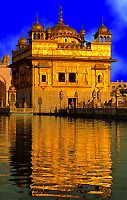 Darbar Sahib (The Royal Court of the Divine) also known as the
Golden Temple is situated in the
city of Amritsar in Punjab. Darbar Sahib is a living symbol of
the spiritual and historical traditions of the Sikhs. It is a source
of inspiration for all Sikhs. The
temple with it's glistening gold covered exterior stands in the middle
of a square tank with each side about 150m with an 18m path on all four
sides. A 60m causeway traverses the pool to reach the Temple itself
which is 12m square and rests on a 20m square platform in the middle
of The Pool of Nectar. The Darbar Sahib has entrances and doors
on all four sides. Guru Arjun exclaimed; "My faith is for the people
of all castes and all creeds from whichever direction they come and
to whichever direction they bow."
Darbar Sahib (The Royal Court of the Divine) also known as the
Golden Temple is situated in the
city of Amritsar in Punjab. Darbar Sahib is a living symbol of
the spiritual and historical traditions of the Sikhs. It is a source
of inspiration for all Sikhs. The
temple with it's glistening gold covered exterior stands in the middle
of a square tank with each side about 150m with an 18m path on all four
sides. A 60m causeway traverses the pool to reach the Temple itself
which is 12m square and rests on a 20m square platform in the middle
of The Pool of Nectar. The Darbar Sahib has entrances and doors
on all four sides. Guru Arjun exclaimed; "My faith is for the people
of all castes and all creeds from whichever direction they come and
to whichever direction they bow."
Guru Amar Das the Third Sikh Guru asked Ram Das (who would go on to become the Fourth Sikh Guru) to build a central place of congregation for the Sikhs. Guru Ram Das started excavation work in 1577 during his lifetime. Guru Arjun the Fifth Sikh Guru completed excavation of the Tank known as Amritsar (The Pool of Nectar) in 1588. Guru Arjun then started construction of the Temple building itself which was finally completed in 1601. The first edition of the Holy Book of the Sikh's The Guru Granth Sahib was installed there in 1604 with Baba Buddha as the first granthi (caretaker of the book). The last Sikh Guru to live in Amritsar was the Sixth Guru, Guru Hargobind. In 1664 Guru Tegh Bahadur the Ninth Sikh Guru visited Darbar Sahib but was refused entry by the corrupt temple caretakers, The Masands. Darbar Sahib has always been a rallying point for Sikhs throughout it's history. Around 1740 Massa Ranghar, the ruler of Amritsar desecrated the Temple by using it as a dancing hall. He was killed by Mahtab Singh. In 1761 Ahmed Shah Abdali blew up the Temple and filled in the Sacred Tank with refuse. The great Sikh martyr Baba Deep Singh laid down his life in revenge. The construction of the Golden Temple as it appears today was begun in 1764 when Jassa Singh Ahluwalia laid the foundation stone. Many of the doors and domes were covered with copper sheets overlaid with gold during the reign of Maharaja Ranjit Singh. Darbar Sahib was partially damaged by the military invasion of the Indian Army during June 1984.
The Five Holy Takhts:
These Five Gurdwaras known as the Five Takhts (Thrones) have a very
special significance for the Sikh community. They are considered the
seats of Sikh religious authority. Many important decisions concerning
the religious and social life of the Sikh community were made here.
Sri Akal
Takht
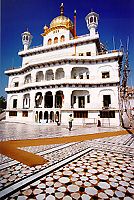 Akal
Takht literally means Eternal Throne. It is part of the Golden Temple
complex in Amritsar. The Akal Takht is situated on the other end of
the causeway connected to the Harmandir Sahib. It's foundation was laid
by Guru Hargobind. It was here that he was ceremonially installed as
Guru in 1606. The building of the Akal Takht opposite the Golden Temple
has a special meaning. While the Golden Temple stands for spiritual
guidance the Akal Takht symbolizes the dispensing of justice and temporal
activity. During the day the Guru Granth Sahib is kept in the Golden
Temple, while at night it is kept in the Akal Takht. Traditionally all
Sikh warriors sought blessings here before going to battle. During the
18th century while Sikhs were fighting a guerrilla war in the forests
they used to gather at the Akal Takht on special occasions such as Baisakhi
and Diwali. Here the community used to have general meetings and approve
resolutions. The Akal Takht was the oldest of the Five Takhts, but it
was destroyed by the Indian Army during its military invasion in 1984.
It's reconstruction is almost complete.
Akal
Takht literally means Eternal Throne. It is part of the Golden Temple
complex in Amritsar. The Akal Takht is situated on the other end of
the causeway connected to the Harmandir Sahib. It's foundation was laid
by Guru Hargobind. It was here that he was ceremonially installed as
Guru in 1606. The building of the Akal Takht opposite the Golden Temple
has a special meaning. While the Golden Temple stands for spiritual
guidance the Akal Takht symbolizes the dispensing of justice and temporal
activity. During the day the Guru Granth Sahib is kept in the Golden
Temple, while at night it is kept in the Akal Takht. Traditionally all
Sikh warriors sought blessings here before going to battle. During the
18th century while Sikhs were fighting a guerrilla war in the forests
they used to gather at the Akal Takht on special occasions such as Baisakhi
and Diwali. Here the community used to have general meetings and approve
resolutions. The Akal Takht was the oldest of the Five Takhts, but it
was destroyed by the Indian Army during its military invasion in 1984.
It's reconstruction is almost complete.
Takht Sri Damdama Sahib
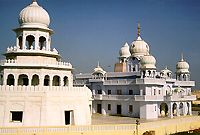
Damdama Sahib is situated in the village of Talwandi Sabo near Bhatinda.
This is where Guru Gobind Singh stayed for nearly a year and compiled
the final edition of the Guru Granth Sahib known as the Damdama Sahib
Bir in 1705.
Takht Sri Keshgarh Sahib

Keshgarh Sahib is situated at Anandpur. It is considered the birthplace
of the Khalsa. The Khalsa order was founded here by Guru Gobind Singh
in 1699. Some of the weapons of Guru Gobind Singh are displayed here.
The most precious of these is the actual Khanda (double edged sword)
used by Guru Gobind Singh to prepare the amrit (sweet water) used in
the first Khalsa initiation ceremony.
Takht Sri Hazur Sahib
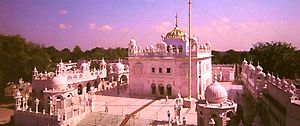
Hazur Sahib is on the banks of Godavari in Maharashtra. This is where
Guru Gobind Singh left this world. The inner room of the temple is called
Angitha Sahib and is built over the place where Guru Gobind Singh was
cremated in 1708.
Takht Sri Patna Sahib
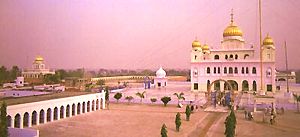
Patna Sahib is situated in Patna the capital of Bihar. It was here that
Guru Gobind Singh was born in 1666 and spent his early years before
moving to Anandpur. Besides being the birthplace of Guru Gobind Singh,
Patna was also honoured by visits from Guru Nanak as well as Guru Tegh
Bahadur.

